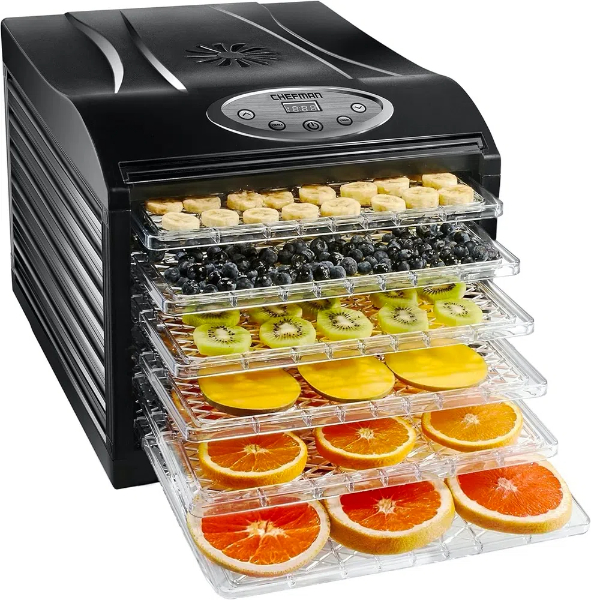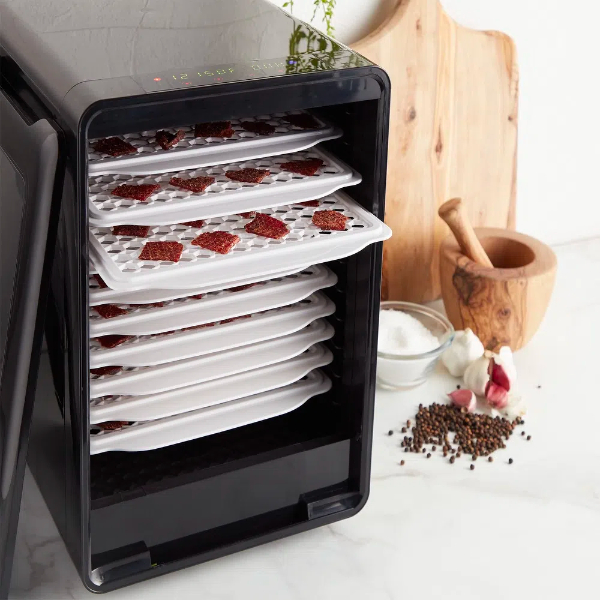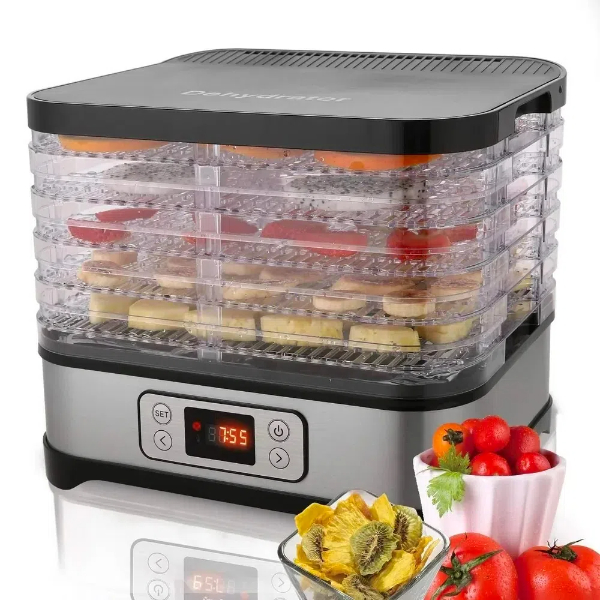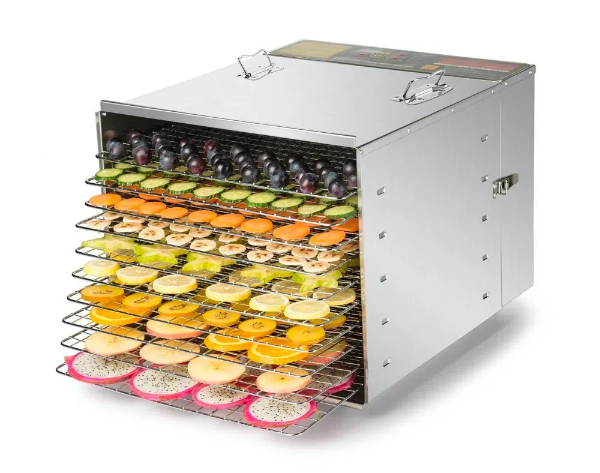
Content Menu
● Introduction to Food Dehydration
● Understanding Food Dehydrators
>> Key Features of Modern Food Dehydrators
● Choosing the Best Food Dehydrator for Your Needs
● Popular Uses for Food Dehydrators
>> 1. Fruit and Vegetable Dehydration
>> 2. Making Beef Jerky
>> 3. Preserving Herbs and Spices
>> 4. Making Fruit Leathers
>> 5. Crafting Dried Flower Arrangements
● Tips for Successful Food Dehydration
● The Benefits of Owning a Food Dehydrator
● Exploring Advanced Dehydration Techniques
● Maintaining Your Food Dehydrator
● Conclusion
● Frequently Asked Questions
>> Q1: What is the best food dehydrator for making jerky?
>> Q2: How long does it take to dehydrate fruits and vegetables?
>> Q3: Are food dehydrators energy-efficient?
>> Q4: Can I dehydrate different foods at the same time?
>> Q5: How long do dehydrated foods last?
Introduction to Food Dehydration
Food dehydration is an ancient preservation technique that has stood the test of time. In today's fast-paced world, where convenience and nutrition often clash, food dehydrators have emerged as a game-changing appliance for health-conscious individuals and culinary enthusiasts alike. These versatile machines allow you to preserve a wide variety of foods, from fruits and vegetables to meats and herbs, while retaining their nutritional value and enhancing their flavors.
Understanding Food Dehydrators
A food dehydrator is an appliance designed to remove moisture from food items, effectively preserving them for long-term storage. By circulating warm air around the food, these machines slowly evaporate water content, inhibiting the growth of bacteria and mold. This process not only extends the shelf life of foods but also concentrates their flavors, making them perfect for creating delicious snacks and ingredients.
Key Features of Modern Food Dehydrators
1. Temperature Control: Most high-quality dehydrators come with adjustable temperature settings, allowing you to customize the drying process for different types of foods.
2. Digital Timer: A digital timer feature enables you to set precise drying times, ensuring optimal results without constant monitoring.
3. Multiple Trays: Multi-tray food dehydrators provide ample space for drying large quantities of food simultaneously, making them ideal for batch processing.
4. Stainless Steel Trays: Many premium models feature stainless steel food dehydrator trays, which are durable, easy to clean, and resistant to staining and odors.
5. Energy Efficiency: Modern dehydrators are designed to be energy-efficient, consuming less power while still delivering excellent results.

Choosing the Best Food Dehydrator for Your Needs
When selecting a food dehydrator, consider the following factors:
1. Capacity: Determine how much food you plan to dehydrate regularly. If you have a large garden or enjoy making bulk snacks, opt for a model with multiple trays.
2. Temperature Range: Look for a dehydrator with a wide temperature range to accommodate various food types. For example, herbs require lower temperatures, while jerky needs higher heat.
3. Noise Level: Some dehydrators can be noisy during operation. If this is a concern, look for models advertised as quiet or silent.
4. Ease of Use: Choose a dehydrator with intuitive controls and easy-to-clean components.
5. Additional Features: Consider extras like transparent doors for easy monitoring, expandable trays, or included accessories like fruit leather sheets.
Popular Uses for Food Dehydrators
1. Fruit and Vegetable Dehydration
One of the most common uses for food dehydrators is creating healthy, preservative-free dried fruit and vegetable snacks. From classic apple chips to exotic dried mango slices, the possibilities are endless. Dehydrated fruits retain much of their nutritional value while concentrating natural sugars, resulting in sweet and chewy treats.
2. Making Beef Jerky
For meat lovers, a food dehydrator is the perfect tool for creating homemade beef jerky. By controlling the temperature and drying time, you can achieve the ideal texture and flavor for your jerky. Experiment with different marinades and spice blends to create unique flavor profiles.
3. Preserving Herbs and Spices
Dehydrators are excellent for preserving fresh herbs from your garden. Dried herbs retain their aromatic oils and can be stored for months, allowing you to enjoy homegrown flavors year-round. You can also create your own spice blends by dehydrating and grinding various ingredients.
4. Making Fruit Leathers
Fruit leathers, also known as fruit rolls, are a fun and healthy snack that can be easily made in a food dehydrator. Simply puree your favorite fruits, spread the mixture on a fruit leather sheet, and dehydrate until pliable. These natural fruit snacks are perfect for kids and adults alike.
5. Crafting Dried Flower Arrangements
Beyond food preservation, dehydrators can be used to dry flowers for crafting and decoration. Create beautiful, long-lasting floral arrangements or preserve special blooms from your garden.

Tips for Successful Food Dehydration
1. Prepare foods uniformly: Cut fruits, vegetables, and meats into even-sized pieces to ensure consistent drying.
2. Pre-treat fruits: Dip sliced fruits in lemon juice or ascorbic acid solution to prevent browning and maintain color.
3. Use the right temperature: Follow recommended temperature guidelines for different food types to achieve the best results.
4. Rotate trays: For even drying, rotate the trays periodically during the dehydration process.
5. Store properly: Once dehydrated, store foods in airtight containers in a cool, dark place to maximize shelf life.
The Benefits of Owning a Food Dehydrator
1. Cost-Effective: By dehydrating foods at home, you can save money on expensive store-bought dried snacks and preserve seasonal produce for year-round enjoyment.
2. Healthier Snacking: Create nutritious, additive-free snacks that are perfect for on-the-go eating or as part of a balanced diet.
3. Reduced Food Waste: Dehydrate excess produce from your garden or take advantage of bulk sales at the grocery store, minimizing food waste.
4. Customization: Control the ingredients and flavors in your dried foods, catering to personal preferences and dietary requirements.
5. Space-Saving Food Storage: Dehydrated foods take up less space than their fresh counterparts, making them ideal for small kitchens or long-term storage.
Exploring Advanced Dehydration Techniques
As you become more comfortable with your food dehydrator, consider exploring these advanced techniques:
1. Dehydrating Meals for Camping: Create lightweight, nutritious meals for outdoor adventures by dehydrating complete dishes like stews or pasta sauces.
2. Making Pet Treats: Craft healthy, preservative-free treats for your furry friends using lean meats, fruits, and vegetables.
3. Crafting Dried Soup Mixes: Dehydrate vegetables and herbs to create your own instant soup mixes for quick, comforting meals.
4. Creating Powders: Dehydrate fruits, vegetables, or herbs and grind them into powders for use in smoothies, baking, or as natural food colorings.
5. Fermenting and Dehydrating: Combine fermentation with dehydration to create unique, probiotic-rich snacks like dehydrated kimchi or sauerkraut chips.
Maintaining Your Food Dehydrator
To ensure your food dehydrator continues to perform optimally, follow these maintenance tips:
1. Clean thoroughly after each use: Wash trays and other removable parts with warm, soapy water.
2. Check for mineral buildup: If you live in an area with hard water, periodically descale your dehydrator to prevent mineral deposits.
3. Inspect the fan and heating element: Ensure these components are free from dust and debris for efficient operation.
4. Store properly: When not in use, store your dehydrator in a clean, dry place to prevent dust accumulation.
5. Replace parts as needed: Over time, trays or other components may wear out. Replace them promptly to maintain optimal performance.
Conclusion
Food dehydrators are versatile appliances that open up a world of culinary possibilities while promoting healthy eating and reducing food waste. Whether you're a seasoned chef or a health-conscious home cook, investing in a quality food dehydrator can revolutionize your approach to food preservation and snack preparation. By understanding the features, techniques, and benefits of food dehydration, you can make the most of this ancient preservation method in your modern kitchen.

Frequently Asked Questions
Q1: What is the best food dehydrator for making jerky?
A1: The best food dehydrator for jerky should have adjustable temperature controls, multiple trays, and good airflow. Models like the Excalibur 3926TB or the COSORI Premium Food Dehydrator are highly rated for jerky making due to their precise temperature control and spacious designs.
Q2: How long does it take to dehydrate fruits and vegetables?
A2: Drying times vary depending on the food type, thickness, and desired texture. On average, fruits can take 6-16 hours, while vegetables may take 4-14 hours. Always refer to your dehydrator's manual for specific guidelines.
Q3: Are food dehydrators energy-efficient?
A3: Modern food dehydrators are designed to be energy-efficient. While they may run for extended periods, they typically use less energy than an oven. Look for models with energy-saving features for optimal efficiency.
Q4: Can I dehydrate different foods at the same time?
A4: It's generally best to dehydrate similar foods together, as different foods may require varying temperatures and drying times. However, if the foods have similar drying requirements, you can dehydrate them simultaneously.
Q5: How long do dehydrated foods last?
A5: Properly dehydrated and stored foods can last anywhere from 6 months to a year or more. Factors like food type, storage conditions, and packaging affect shelf life. Always store dehydrated foods in airtight containers in a cool, dark place for maximum longevity.












